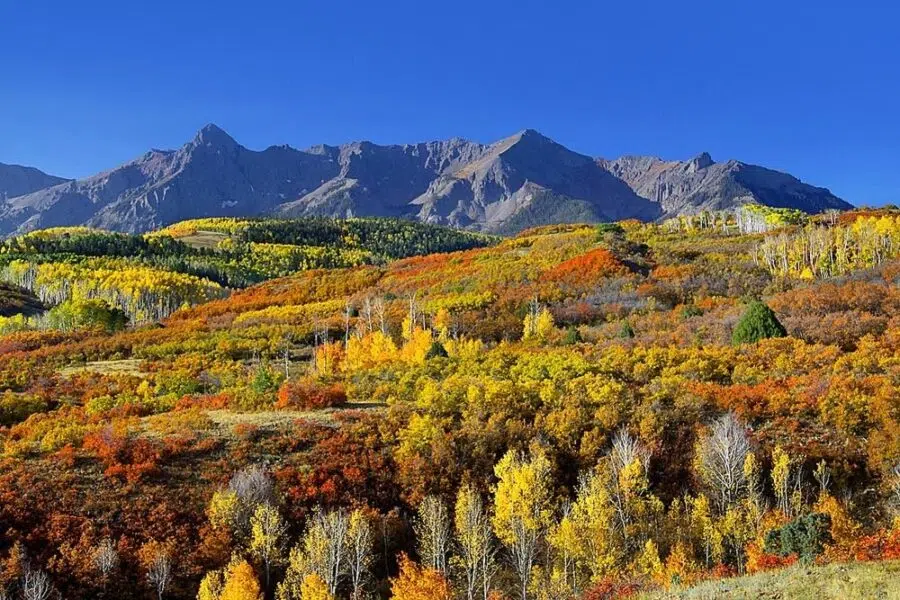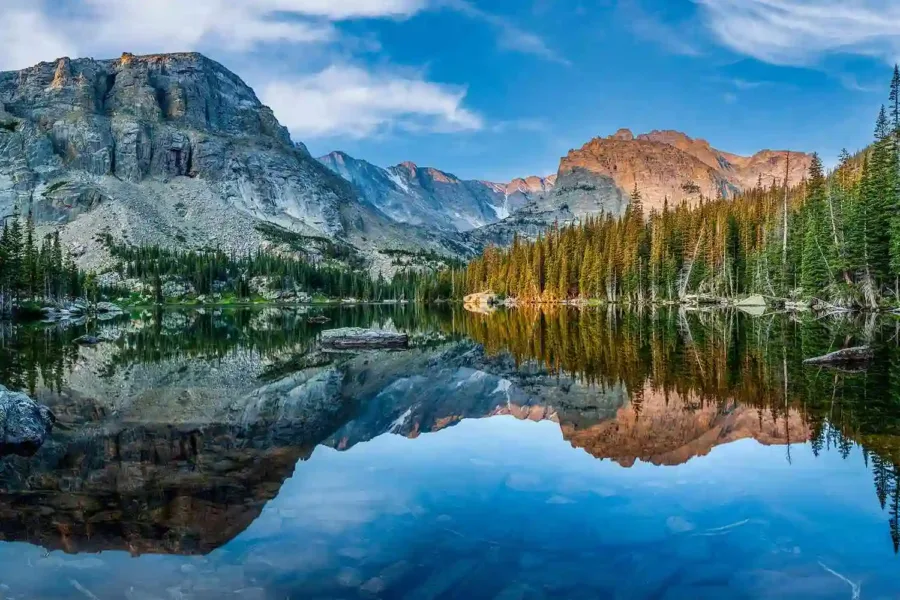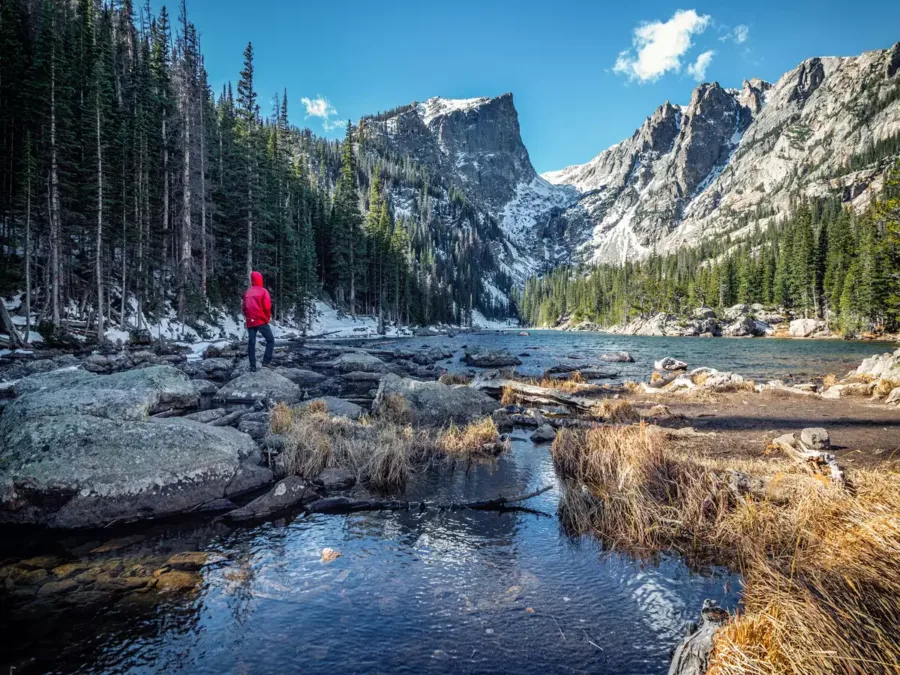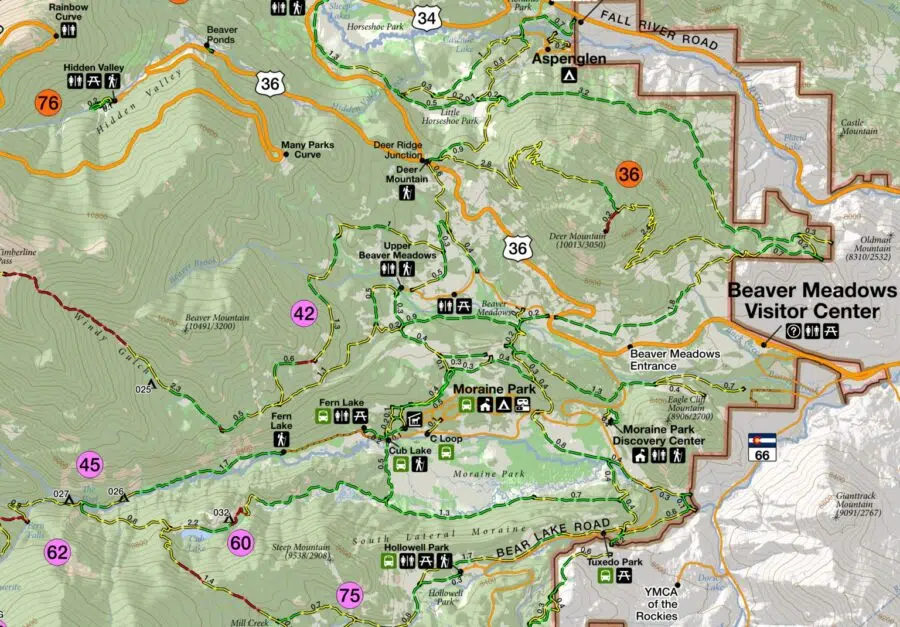Rocky Mountain National Park
Rocky Mountain National Park, a breathtaking wilderness in Colorado, beckons nature enthusiasts and adventurers alike. This iconic national park is renowned for its awe-inspiring landscapes, encompassing soaring peaks, pristine alpine lakes, and diverse ecosystems. With its dramatic vistas and abundant wildlife, it’s a haven for hikers, climbers, and photographers. Explore the meandering trails that lead you to tranquil lakes, and keep your camera ready for capturing the splendor of elk, mule deer, and bighorn sheep. Rocky Mountain National Park is a must-visit destination for anyone seeking the raw beauty of the Rocky Mountains. Whether you’re an avid hiker or simply yearning for a scenic escape, this park offers an unforgettable experience in the heart of the Rockies.
Rocky Mountain National Park History
Rocky Mountain National Park, established in 1915, boasts a rich history of preservation and appreciation for its natural wonders. This protected expanse covers approximately 1,075 square kilometers (415 square miles) of the Colorado Rocky Mountains. The idea of preserving this pristine landscape was championed by Enos Mills, who tirelessly lobbied for its protection, leading to its designation as a national park. Over the years, the park has been a source of inspiration for artists, writers, and explorers, offering a glimpse into the unique ecosystems of the high-altitude Rocky Mountains. Today, it stands as a testament to the dedication of those who recognized its significance, making it a cherished destination for visitors seeking both adventure and a deeper connection with the natural world.
Rocky Mountain National Park Facts
Rocky Mountain National Park, spanning 415 square miles (1,075 sq km) in the Colorado Rockies, is a treasure trove of fascinating facts. This park is home to over 300 miles of hiking trails, including the famous Longs Peak Trail, which leads to the park’s highest summit. Its elevation ranges from 7,840 to 14,259 feet, offering diverse ecosystems and incredible biodiversity. The park shelters a variety of wildlife, including elk, mule deer, moose, and more.
Rocky Mountain National Park is renowned for its stunning alpine lakes, such as Bear Lake and Dream Lake, reflecting the majesty of the surrounding peaks. Additionally, it contains over 50 peaks that exceed 12,000 feet, making it a paradise for climbers and mountaineers. Trail Ridge Road, the highest continuously paved road in the United States, provides breathtaking vistas, allowing visitors to experience an alpine environment accessible by car.
Rocky Mountain National Park Visitor Center
Rocky Mountain National Park is home to several visitor centers that serve as invaluable hubs for park exploration. These centers, like Beaver Meadows Visitor Center and Kawuneeche Visitor Center, are essential resources for visitors, offering maps, exhibits, and the expertise of park rangers. They typically operate seasonally, from spring through fall, providing a wealth of information on the park’s natural wonders and helping you plan your visit effectively. For the most current information on visitor center locations and hours, it’s best to consult the official Rocky Mountain National Park website before your trip.
Rocky Mountain National Park Entrance Fee
The updated entrance fees for Rocky Mountain National Park are as follows: For private vehicles, the cost is $30 during the park’s off-peak season (typically late fall and winter) and $35 during the peak season. If you’re entering the park on foot or by bicycle, the fee is $15 per person in the off-peak season and $20 per person during the peak season. For motorcycles, the fee is $25 off-peak and $30 during the peak season. These fees support the maintenance and preservation of this magnificent natural treasure. It’s important to check the official park website for any possible updates or changes to these fees before your visit.
Rocky Mountain National Park Hours
Rocky Mountain National Park welcomes visitors 24 hours a day, year-round, as long as weather conditions permit safe access. The park experiences its highest visitation during the summer and fall seasons, which can lead to crowded parking lots and congested roads. To enhance your experience, consider arriving early in the day or entering the park in the late afternoon, as this can help you avoid the peak traffic and parking challenges often encountered during busier times.
Things to do in Rocky Mountain National Park

Rocky Mountain National Park offers a plethora of activities to engage with its breathtaking natural beauty. Here are some must-do things in the park:
- Hiking: Explore over 300 miles of hiking trails, ranging from easy strolls to challenging alpine adventures. Don’t miss the trails to Dream Lake, Emerald Lake, and the iconic Longs Peak.
- Scenic Drives: Take a drive on Trail Ridge Road, one of the most scenic routes in the U.S., and enjoy stunning vistas of the high-altitude landscape.
- Wildlife Viewing: Keep an eye out for elk, mule deer, moose, bighorn sheep, and various bird species. Moraine Park and Horseshoe Park are great spots for wildlife sightings.
- Photography: With its dramatic landscapes, Rocky Mountain National Park is a paradise for photographers. Capture the sunrise at Bear Lake or the sunset at Many Parks Curve.
- Climbing and Mountaineering: If you’re an experienced climber, tackle the park’s numerous peaks, including the challenging Longs Peak.
- Camping: Enjoy the serenity of the Rockies by camping in one of the park’s campgrounds. Reservations are recommended.
- Stargazing: Rocky Mountain National Park’s high elevation and clear skies make it an ideal place for stargazing. Attend ranger-led astronomy programs for an enhanced experience.
- Ranger-Led Programs: Join ranger-led programs to learn more about the park’s natural and cultural history.
- Winter Activities: In the winter, the park offers opportunities for snowshoeing, cross-country skiing, and winter wildlife viewing.
- Visitor Centers: Visit the park’s visitor centers to get information, maps, and learn about the park’s history and geology.
Remember to check current conditions and any park alerts before your visit, and consider the seasonal variations when planning your activities.
Trail Ridge Road
Trail Ridge Road, located in Rocky Mountain National Park, is one of the most iconic and breathtaking drives in the United States. This high-elevation road winds its way through the heart of the Rockies, reaching elevations over 12,000 feet. It offers stunning vistas of alpine landscapes, with numerous overlooks to stop and admire the scenery. The road is typically open from late spring through early fall, weather permitting. It provides access to a unique alpine environment, and travelers can expect to encounter varying weather conditions, from sunshine to snow, so checking road conditions before your journey is advisable.
Rocky Mountain National Park Camping
Rocky Mountain National Park provides a fantastic camping experience amidst its stunning natural beauty. Some famous campgrounds within the park include Moraine Park Campground, , and Glacier Basin Campground, offering both tent and RV sites. These campgrounds are ideal for exploring the park’s diverse landscapes, and they tend to be in high demand, so reservations are highly recommended, especially during the busy summer season. For those seeking a more rugged experience, backcountry camping permits are available to venture into the wilderness. Be sure to visit the official Rocky Mountain National Park website to check campground details, availability, and make reservations to secure your camping spot.
Glacier Basin Campground
Glacier Basin Campground, located in Rocky Mountain National Park, offers a serene camping experience. It provides both tent and RV sites, making it accessible to various campers. This picturesque campground is an ideal base for exploring the park’s attractions, including nearby trails like Alberta Falls. Due to its popularity, it’s recommended to make advance reservations to secure your spot in this beautiful natural setting
Moraine Park Campground
Moraine Park Campground, situated in the heart of Rocky Mountain National Park, is a popular camping destination. It offers both tent and RV sites, making it suitable for a range of campers. This campground is known for its stunning surroundings, with close proximity to beautiful trails and the enchanting Moraine Park. Reservations are advised, particularly during the busy season, to secure your spot in this picturesque setting.
Aspenglen Campground
Aspenglen Campground in Rocky Mountain National Park is a serene camping location. It offers tent and RV sites for campers. The campground is known for its proximity to scenic spots like the Fall River and a range of trails. Due to its popularity, making reservations in advance is recommended.
Camping near Estes Park
Camping near Estes Park, a gateway town to Rocky Mountain National Park, offers various options to immerse yourself in the natural beauty of the area. Some popular campgrounds and areas for camping near Estes Park include:
- Hermit Park Open Space: This nearby park provides camping opportunities in a serene mountain setting with various campsites for tents and RVs.
- Mary’s Lake Campground: Located in Estes Park, this campground offers RV sites and cabin rentals, providing convenient access to both the town and the national park.
- Estes Park Campground at Mary’s Lake: Another option near town, this campground has a variety of campsites, including RV and tent sites.
- Manor RV Park: Ideal for RV campers, this park is conveniently located in Estes Park.
- National Forest Campgrounds: There are several campgrounds in the nearby Roosevelt National Forest, offering a rustic and natural camping experience.
Remember to make reservations in advance, especially during the peak summer season, to secure your camping spot near Estes Park.
Lakes in Rocky Mountain National Park

Rocky Mountain National Park boasts a multitude of stunning alpine lakes, each with its unique charm. Notable ones include Bear Lake, a gem nestled in the heart of the park, known for its crystal-clear waters and accessible trails. Dream Lake, with its reflective surface mirroring Hallett Peak, is another favorite. Additionally, Mills Lake, Loch Vale, and Sprague Lake offer picturesque settings for hiking, picnicking, and wildlife watching amidst the Rocky Mountains’ grandeur.
Bear Lake Rocky Mountain National Park
Bear Lake, located in Rocky Mountain National Park, is a pristine alpine lake known for its breathtaking beauty. Its crystal-clear waters reflect the surrounding peaks, creating a mesmerizing scene. The lake is easily accessible and serves as a trailhead for various hikes, including those to Nymph Lake and Dream Lake. Bear Lake is a must-visit destination for both its serene ambiance and its role as a gateway to stunning mountain adventures.
Emerald Lake Rocky Mountain National Park
Emerald Lake, situated in Rocky Mountain National Park, is a jewel among the park’s alpine lakes. The lake is known for its vibrant green hue, surrounded by towering peaks and serene forests. It’s accessible via a picturesque hike from the Bear Lake Trailhead. The trail offers remarkable views, and once you reach Emerald Lake, the stunning scenery makes it a rewarding destination for hikers and nature enthusiasts.
Dream lake rocky mountain national park
Dream Lake, nestled in the heart of Rocky Mountain National Park, is a place of enchanting beauty. Surrounded by towering peaks, this alpine lake captivates visitors with its tranquil waters and breathtaking mountain reflections. It’s accessible via a picturesque trail from the Bear Lake Trailhead, making it a popular destination for hikers and photographers. Dream Lake’s serene ambiance and captivating scenery make it a must-see spot in the park.
Hiking in Rocky Mountain National Park

Hiking in Rocky Mountain National Park is a journey through some of the most captivating and diverse landscapes in the country. With over 300 miles of trails, there’s a path for every level of hiker. From serene strolls around alpine lakes to challenging ascents of towering peaks, the park offers endless opportunities for exploration. Don’t miss iconic trails like the one leading to Dream Lake or the challenging Longs Peak Trail. Remember to check trail conditions and be prepared for changing weather, as the Rockies offer an ever-changing and unforgettable hiking experience.
Trails in Rocky Mountain National Park
Rocky Mountain National Park offers an extensive network of trails, totaling over 300 miles, catering to hikers of all skill levels. Among the most famous trails, the Bear Lake Trailhead is a gateway to stunning alpine lakes, including Dream Lake and Emerald Lake, with their reflective waters and towering peaks. The challenging Longs Peak Trail leads to the park’s highest summit, while the Loch Vale Trail and Sky Pond Trail offer captivating alpine experiences. Exploring these trails provides a diverse range of environments, from serene lakes to rugged mountain terrain, ensuring an unforgettable hiking adventure in the Rockies. Always check trail conditions and prepare for changing weather conditions and high altitudes.
Waterfalls in Rocky Mountain National Park
Rocky Mountain National Park is graced with numerous picturesque waterfalls, each with its unique charm. Alberta Falls is a popular choice, easily accessible via a scenic trail. It’s known for its impressive cascade, surrounded by lush greenery. Further up, The Loch Vale Trail leads to Timberline Falls, where the trail itself seems to become part of the waterfall’s path.
Fern Falls, a bit off the beaten path, offers a tranquil and less crowded experience. And then there’s Chasm Falls, which you can view from your vehicle along the Old Fall River Road.
These waterfalls are not only stunning natural wonders but also rewarding destinations for hikers and photographers. Be sure to check trail conditions and accessibility before your visit to enjoy these captivating falls safely.
Best time to visit Rocky Mountain National Park
Rocky Mountain National Park is graced with numerous picturesque waterfalls, each with its unique charm. Alberta Falls is a popular choice, easily accessible via a scenic trail. It’s known for its impressive cascade, surrounded by lush greenery. Further up, The Loch Vale Trail leads to Timberline Falls, where the trail itself seems to become part of the waterfall’s path.
Fern Falls, a bit off the beaten path, offers a tranquil and less crowded experience. And then there’s Chasm Falls, which you can view from your vehicle along the Old Fall River Road.
These waterfalls are not only stunning natural wonders but also rewarding destinations for hikers and photographers. Be sure to check trail conditions and accessibility before your visit to enjoy these captivating falls safely.
Here are few other National Parks that are worth a visit Olympic National Park, Yellowstone National Park, Arches National Park, Acadia National park and many more. Visit this website and find articles on other travel destinations and plan your holidays.
Rocky Mountain National Park Weather
Rocky Mountain National Park experiences varied weather due to its high-altitude location. Summers, from June to August, are generally mild with daytime temperatures ranging from 70 to 80°F, but afternoon thunderstorms are common. Fall, in September and October, offers cooler weather with daytime highs in the 50s and 60s°F. Winter, from November to April, is cold, with daytime temperatures typically below freezing and significant snowfall, making it ideal for winter sports. Spring, from April to June, sees gradually warming temperatures. It’s crucial to check the forecast before visiting, as weather conditions can change rapidly, especially at higher elevations.
Hotels in Rocky Mountain National Park
Rocky Mountain National Park doesn’t have hotels within its boundaries, but there are accommodations in nearby gateway towns. Estes Park, just east of the park, offers a range of lodging options, including hotels, lodges, and cabins. Grand Lake, situated on the western side of the park, also has lodging choices. Both towns provide convenient access to the park’s entrances. Estes Park boasts a wide variety of amenities, while Grand Lake offers a more tranquil setting. It’s advisable to make reservations in advance, especially during the park’s busy seasons, to ensure a comfortable stay while exploring the park’s natural wonders.
Rocky Mountain National Park Map

